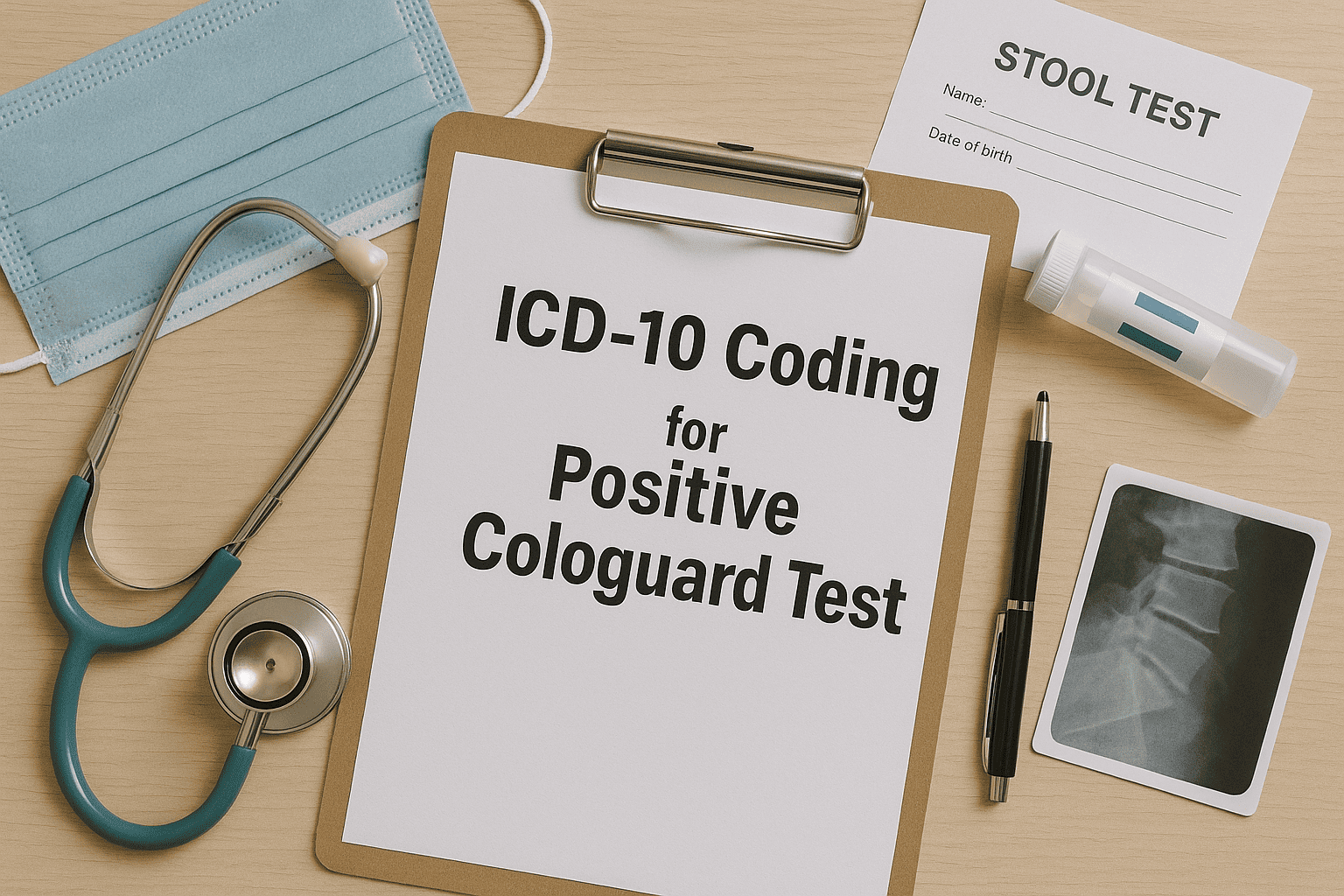Updated on: July 21, 2025
A positive Cologuard result can be a pivotal moment in a patient’s journey—triggering anxiety, follow-up procedures, and more detailed clinical conversations. As a clinician, your job is to ensure that each of those steps is well-documented, clearly coded, and easy to follow.
But let’s face it: documenting “positive Cologuard” cases comes with its own nuances—especially when integrating findings with ICD-10 coding, screening history, and follow-up colonoscopy recommendations.
That’s where AI medical scribe tools like DocScrib shine. They help streamline your workflow, reduce documentation time, and improve billing compliance—so you can focus more on your patient, and less on your notes.
What Is a Cologuard Test?
Cologuard is a non-invasive stool-based DNA test designed to screen for colorectal cancer (CRC) and precancerous polyps. It’s typically recommended every 3 years for average-risk patients aged 45 to 75.
The test looks for:
-
Abnormal DNA from cancer or polyps
-
Occult (hidden) blood in the stool
A positive result indicates potential DNA or blood abnormalities and warrants follow-up diagnostic colonoscopy to investigate further.
What a Positive Cologuard Result Means for Clinicians
When a patient tests positive on Cologuard, the next steps are critical:
Clinical Actions:
-
Inform the patient and explain the meaning of a positive result
-
Order a diagnostic colonoscopy
-
Document the absence or presence of symptoms (e.g., bleeding, weight loss)
-
Note patient history, risk factors, and prior screening tests
Communication Priorities:
-
Address anxiety or misconceptions (“Does this mean I have cancer?”)
-
Reinforce that this is a screening tool, not a definitive diagnosis
-
Encourage prompt follow-up
ICD-10 Coding for Positive Cologuard
Primary ICD-10 Code:
| ICD-10 Code | Description |
|---|---|
| R19.5 | Other fecal abnormalities (includes abnormal DNA or occult blood findings in stool) |
Related Codes & Use Cases:
| ICD-10 Code | When to Use |
|---|---|
| Z12.11 | Encounter for screening for malignant neoplasm of colon (use during initial Cologuard ordering visit) |
| R19.4 | Change in bowel habit (if patient presents with symptoms like diarrhea or constipation) |
| K92.1 | Melena (if there’s a history of black, tarry stools) |
| Z86.010 | Personal history of colonic polyps |
| Z80.0 | Family history of colorectal cancer |
| D12.6 | Benign neoplasm of colon (if polyps are found later on colonoscopy) |
💡 Remember: Once the Cologuard comes back positive, Z12.11 (screening) is no longer appropriate for that visit. Instead, use R19.5 or other diagnostic codes reflecting abnormal findings.
Clinical Scenario Example
Scenario: 54-year-old asymptomatic patient with positive Cologuard
Visit 1:
-
Code: R19.5
-
Action: Schedule colonoscopy, review family history, document risk factors
Visit 2 (Colonoscopy Results):
-
If polyps found: D12.6
-
If cancer detected: C18.9 (Malignant neoplasm of colon, unspecified)
-
If normal: Z09 (Encounter for follow-up exam after abnormal screening result)
DocScrib tracks this workflow automatically and prompts appropriate code suggestions at each step.
How DocScrib Simplifies Positive Cologuard Documentation
DocScrib is your AI-powered partner that listens during the visit, understands clinical context, and automatically generates structured notes and accurate codes for positive Cologuard encounters.
🧠 Built-In Clinical Intelligence
-
Recognizes terms like “positive stool DNA test,” “Cologuard,” “abnormal DNA,” and “follow-up colonoscopy”
-
Flags appropriate ICD-10 codes like R19.5, Z86.010, or D12.6 based on your spoken notes
✍️ Auto-Generated Documentation
-
Populates HPI, Assessment & Plan, and ICD-10 suggestions with complete phrasing and compliance-ready language
🕒 Reduces Charting Time
-
Cuts down on after-hours EHR use
-
Improves note completeness and audit readiness
✅ Want to see how DocScrib supports GI and primary care workflows?
Book your free personalized demo now
Key Documentation Tips for Positive Cologuard
When charting a case with a positive Cologuard, make sure your note includes:
-
Reason for testing (e.g., routine screening, age, family history)
-
Date and result of Cologuard test
-
Symptom status (asymptomatic or presenting complaints)
-
Next steps (referral to GI, colonoscopy order, patient counseling)
-
Any prior colonoscopy results or deferrals
DocScrib ensures none of this gets missed—with real-time prompts and auto-filled templates.
FAQs
What ICD-10 code should I use for a positive Cologuard result?
Use R19.5 (other fecal abnormalities) for abnormal stool DNA findings. Avoid Z12.11 once the result is known to be positive.
Can I still use screening codes after a positive Cologuard?
No. Once the patient has a positive result, the workup is considered diagnostic, not screening. Use R19.5 or any relevant symptomatic code.
Does DocScrib support GI and primary care specialties?
Yes. DocScrib is optimized for both primary care and GI specialists, with templates and code logic built around preventive care, CRC screening, and follow-up workflows.
Will DocScrib track follow-up colonoscopy results?
Yes. DocScrib helps you link abnormal findings to follow-up diagnoses like D12.6 or C18.9, ensuring clean documentation and complete patient history trails.
Final Thoughts: Smarter CRC Screening Documentation Starts with DocScrib
A positive Cologuard test can be the starting point for early detection and intervention—but only if the next steps are clearly documented and accurately coded.
With DocScrib, you’ll never miss a beat:
-
Real-time ICD-10 coding suggestions
-
AI-assisted SOAP note generation
-
Reduced documentation time
-
Seamless EMR integration
👉 Book your DocScrib demo today and see how effortless clinical documentation can be.
